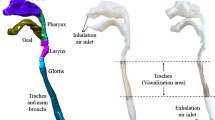Abstract
This experimental study was carried out to investigate the flow field in the human extra-thoracic airway using the particle image velocimetry technique. The purpose of this study is to understand the physics of the turbulent flow in the pharynx/larynx region. The flow rate was 9 l/min, and the corresponding Reynolds number, based on the inlet condition, was 670. Two thousand images were acquired at each location at a framing rate of 2 Hz. The mean turbulence intensity, turbulent kinetic energy and Reynolds stress fields were calculated. Moreover, the proper orthogonal decomposition method and quadrant analysis were also used for investigating the flow in the pharynx/larynx region. The results showed that the flow is strongly three dimensional and is characterised by re-circulation, jet-like and sink-like mean flows. The pharynx/larynx region is characterised by bursting events (e.g. ejection, sweep and interaction events) particularly in the epiglottal region. These events appear to be responsible for deforming and/or tearing apart the vortical structures. In addition, the major contribution to the Reynolds shear stress comes from the events that mainly burst with or against the flow direction which, in some cases, exceeded 100 % of the inlet velocity.












Similar content being viewed by others
References
Agrawal A, Prasad AK (2003) Measurements within vortex cores in a turbulent jet. ASME Trans J Fluids Eng 125(3):561–568
Ball CG, Uddin M, Pollard A (2008a) High resolution turbulence modelling of airflow in an idealised human extrathoracic airway. Comput Fluids 37:943–964
Ball CG, Uddin M, Pollard A (2008b) Mean flow structures inside the human upper airway. Flow Turbul Combust 81:155–188
Bugg JD, Rezkallah KS (1998) An analysis of noise in PIV images. J Vis 1(2):217–226
Doorly D, Taylor DJ, Franke P, Schroter RC (2008) Experimental investigation of nasal airflow. Proc Inst Mech Eng [H] 222:439–453
Gonda I (2003) Targeting by deposition. In: Hickey AJ (ed) Pharmaceutical inhalation aerosol technology, 2nd edn. Marcel Dekker, New York, pp 65–88
Hahn I, Scherer PW, Mozell MM (1993) Velocity profiles measured for air-flow through a large-scale model of the human nasal cavity. J Appl Physiol 75:2273–2287
Heenan AF, Matida E, Pollard A, Finlay WH (2003) Experimental measurements and computational modeling of the flow field in an idealised human oropharynx. Exp Fluids 35:70–84
Hopkins LM, Kelly JT, Wexler AS, Prasad AK (2000) Particle image velocimetry measurements in complex geometries. Exp Fluids 29:91–95
Horschler I, Meinke M, Schroder W (2003) Numerical simulation of the flow field in a model of the nasal cavity. Comput Fluids 32:39–45
Johnstone A, Uddin M, Pollard A, Heenan A, Finlay WH (2004) The flow inside an idealised form of the human extrathoracic airway. Exp Fluids 37:673–689
Keyhani K, Scherer PW, Mozell MM (1995) Numerical simulation of airflow in the human nasal cavity. J Biomech Eng 117:429–441
Kim SK, Chung SK (2004) An investigation on airflow in disordered nasal cavity and its corrected models by tomographic PIV. Meas Sci Technol 15:1090–1096
Kleinstreure C, Zhang Z (2010) Airflow and particle transport in the human respiratory system. Annu Rev Fluid Mech 42:301–334
Liang D, Jiang C, Li Y (2003) Cellular neural network to detect spurious vectors in PIV data. Exp Fluids 34(1):52–62
Lin C-L, Tawhai MH, McLennan G, Hoffman EA (2007) Characteristics of the turbulent laryngeal jet and its effect on airflow in the human intra-thoracic airways. Respir Physiol Neurobiol 157:295–309
Shi H, Kleinstreuer C, Zhang Z (2008) Dilute suspension flow with nanoparticle deposition in a representative nasal airway model. Phys Fluids 20:013301
Shinneeb A-M (2006) Confinement effects in shallow water jets. Ph.D. thesis, University of Saskatchewan, Saskatoon, Canada
Shinneeb A-M, Bugg JD, Balachandar R (2004) Variable threshold outlier identification in PIV data. Meas Sci Technol 15:1722–1732
Shinneeb A-M, Balachandar R, Bugg JD (2008a) Analysis of coherent structures in the far-field region of an axisymmetric free jet identified using particle image velocimetry and proper orthogonal decomposition. ASME J Fluids Eng 130(1):011202
Shinneeb A-M, Bugg JD, Balachandar R (2008b) Quantitative investigation of vortical structures in the near-exit region of an axisymmetric turbulent jet. J Turbulence 9(19):1–20
Shinneeb A-M, Bugg JD, Balachandar R (2011) Coherent structures in shallow water jets. ASME J Fluids Eng 133(1):011203
Sirovich L (1987) Turbulence and the dynamics of coherent structures. Part I: coherent structures. Q Appl Math 45(3):561–571
Stapleton KW, Guentsch E, Hoskinson MK, Finlay WH (2000) On the suitability of k-ε turbulence modeling for aerosol deposition in the mouth and throat: a comparison with experiment. J Aerosol Sci 31(6):739–749
Acknowledgments
The support of the Natural Sciences and Engineering Research Council (NSERC) of Canada is gratefully acknowledged. The authors thank Stan Prunster, a technician in the Department of Civil Engineering at Queen’s university, for providing equipment during the making of the ETA model.
Author information
Authors and Affiliations
Corresponding author
Rights and permissions
About this article
Cite this article
Shinneeb, AM., Pollard, A. Investigation of the flow physics in the human pharynx/larynx region. Exp Fluids 53, 989–1003 (2012). https://doi.org/10.1007/s00348-012-1336-y
Received:
Revised:
Accepted:
Published:
Issue Date:
DOI: https://doi.org/10.1007/s00348-012-1336-y




